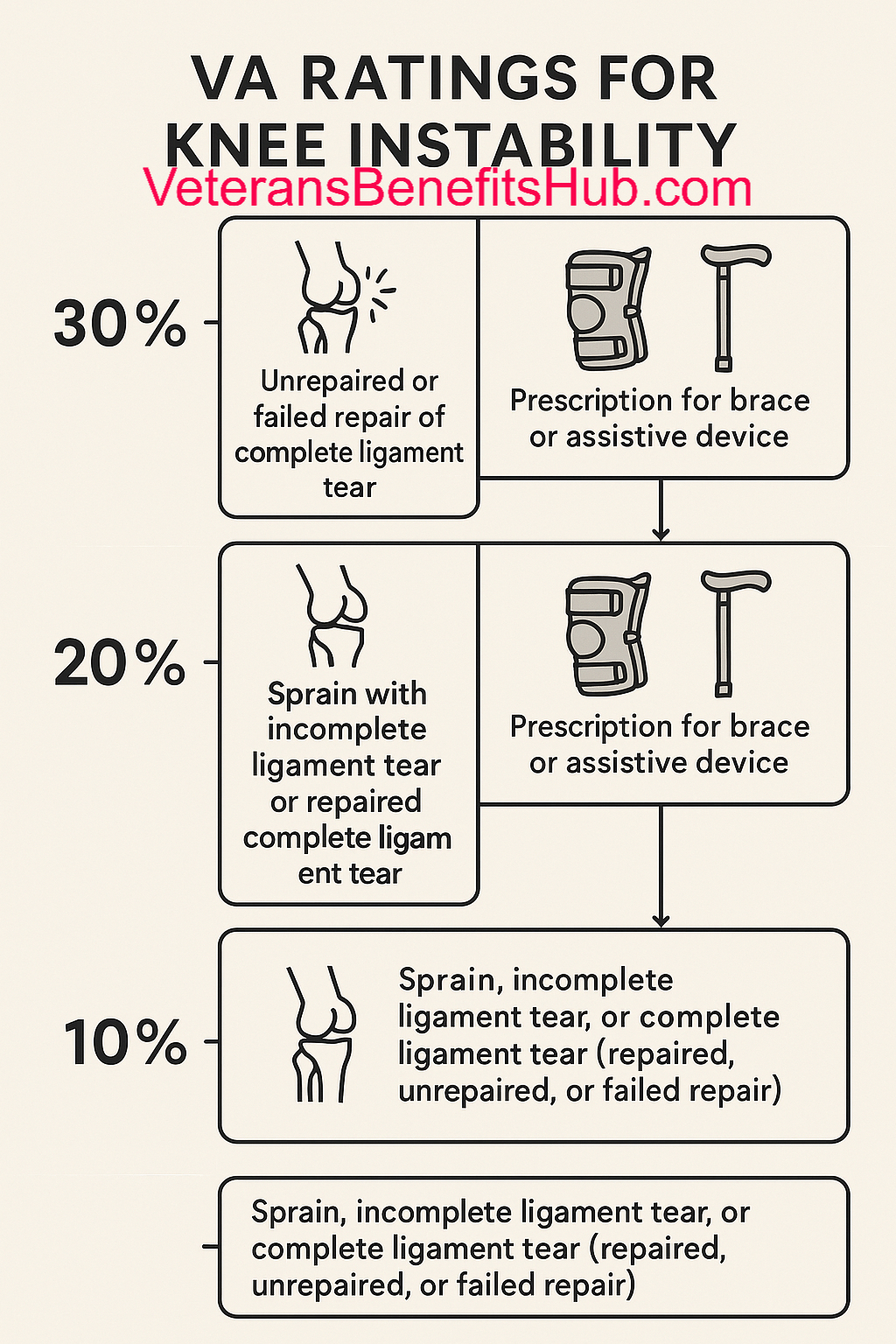Understanding VA Disability Ratings for Knee Instability

Understanding VA Disability Ratings for Knee Instability: New Guidelines Explained
The Department of Veterans Affairs (VA) has updated its rating criteria for knee instability under 38 CFR 4.71A, Diagnostic Code 5257. These changes introduce more specific requirements for veterans seeking disability ratings for knee instability, moving away from the previous vague “mild, moderate, severe” system to a more defined structure. Below, we break down the new 30%, 20%, and 10% ratings for knee instability, including what medical evidence and prescriptions are needed to qualify. We also briefly touch on patellar instability, which follows a similar but distinct rating framework.
30% Rating for Knee Instability
A 30% rating is reserved for severe knee instability, typically involving:
- Unrepaired or failed repair of a complete ligament tear (e.g., ACL or PCL). This indicates significant instability, where the knee frequently gives out due to a complete tear that either hasn’t been surgically addressed or where surgical repair was unsuccessful.
- Prescription for both a brace and an assistive device (e.g., cane, crutches, or walker) by a medical provider. The VA requires documentation in your medical records showing that a healthcare professional has prescribed both a brace and an assistive device to manage instability.
This rating reflects a highly unstable knee that significantly impacts daily activities and mobility, requiring multiple forms of support.
20% Rating for Knee Instability
The 20% rating is more complex, covering two distinct scenarios:
- Sprain with an incomplete ligament tear or a repaired complete ligament tear with residual instability. In these cases, the knee is unstable due to a partial tear or a surgically repaired complete tear that still causes issues. A medical provider must prescribe either a brace or an assistive device (e.g., cane).
- Unrepaired or failed repair of a complete ligament tear (similar to the 30% criteria) but with a key difference: only one prescribed device (either a brace or an assistive device, not both) is required.
The distinction between requiring one versus both devices separates the 20% and 30% ratings. Documentation of the prescription in your medical records is critical for this rating.
10% Rating for Knee Instability
The 10% rating is the most accessible and covers a broad range of scenarios, including:
- Sprain, incomplete ligament tear, or complete ligament tear (repaired, unrepaired, or failed repair) causing persistent instability.
- No prescription for a brace or assistive device is required. This is a key point: even if you use a brace or cane purchased independently (e.g., from a pharmacy), you may still qualify for a 10% rating as long as instability is documented.
Notably, the 10% rating does not require imaging (e.g., an MRI) to confirm a ligament tear. A documented sprain or history of knee instability (e.g., the knee giving out) can suffice, making this rating more attainable for veterans who may not have extensive diagnostic records. For example, if you injured your knee years ago and it continues to cause instability, you could still qualify for this rating without advanced imaging.
Key Considerations for All Ratings
The VA emphasizes the importance of prescriptions documented in your medical records. Even if you use a brace or cane that works better than the one provided by the VA, the prescription itself is what matters for the 20% and 30% ratings. For the 10% rating, no prescription is needed, which lowers the evidentiary burden. Veterans should ensure their healthcare providers document instability and any prescribed devices clearly to support their claim.
From a medical perspective, these updated criteria align with modern orthopedic practices, providing a more structured approach to evaluating knee instability. While the new system is more complex, it aims to ensure ratings reflect the severity of the condition and the level of medical intervention required.
Patellar Instability: A Brief Overview
Patellar instability, where the kneecap (patella) is unstable, is less common than general knee joint instability but follows a similar 30%, 20%, and 10% rating structure. Unlike regular knee instability, patellar instability requires a specific diagnosis. The criteria involve similar combinations of surgical history (e.g., repaired or unrepaired issues), prescriptions for braces or assistive devices, and documented instability. Veterans with patellar instability should ensure their medical records clearly reflect this diagnosis to pursue these ratings.
Conclusion
The VA’s updated knee instability ratings under Diagnostic Code 5257 are more detailed and specific, requiring veterans to provide clear medical evidence, particularly for higher ratings. The 10% rating is the most accessible, as it does not require prescriptions or advanced imaging, making it achievable for many veterans with documented instability. For the 20% and 30% ratings, prescriptions for braces and assistive devices are critical. Veterans should work closely with their healthcare providers to ensure all relevant information is documented in their medical records to support their claims.
Need Help with Your VA Claim?
Navigating VA disability ratings can be challenging. At VeteransBenefitsHub.com, we provide resources and guidance to help veterans understand their benefits and build strong claims. Consult with a Veterans Service Officer (VSO) or accredited representative to maximize your chances of success.
Disclaimer
The information provided in this article is for general informational purposes only and does not constitute legal or medical advice. VeteransBenefitsHub.com is not a law firm or medical provider. The content is based on interpretations of VA regulations and policies, which are subject to change. For personalized guidance, consult with a qualified Veterans Service Officer (VSO), accredited representative, or healthcare professional. Always verify information with official VA sources, such as www.va.gov, before making decisions regarding your benefits or healthcare.